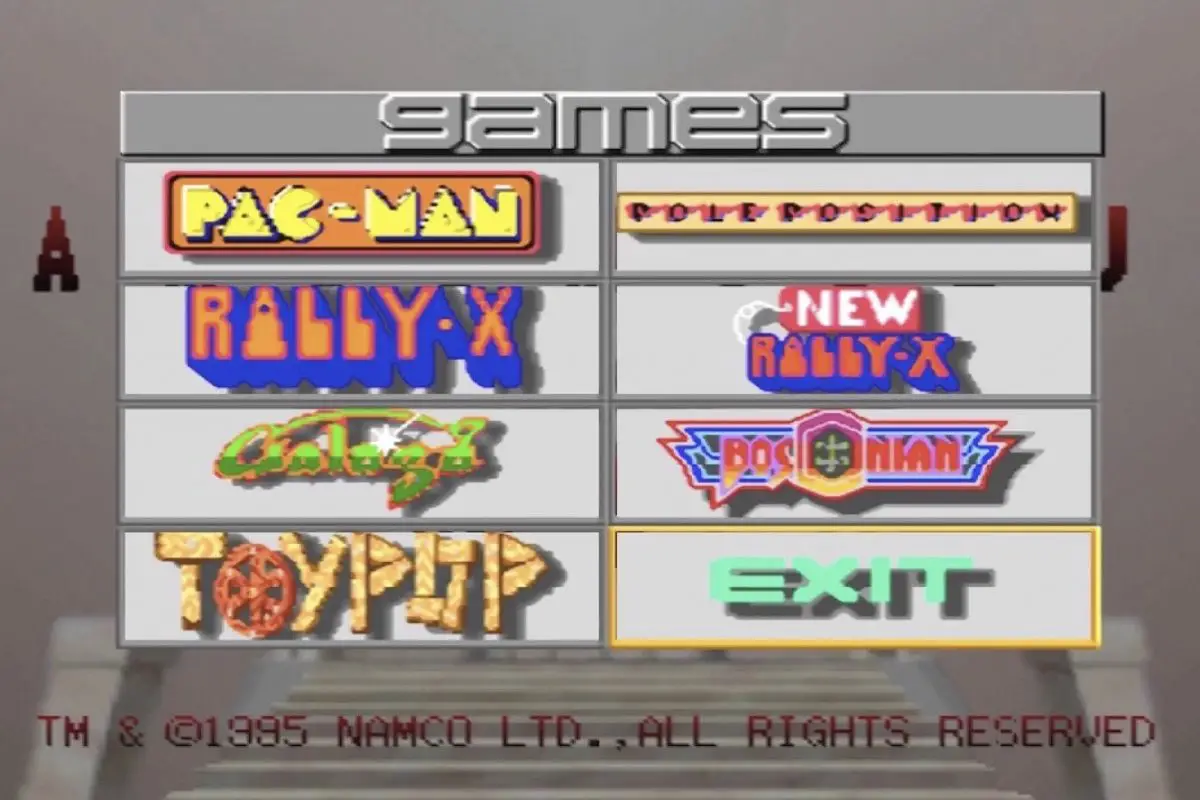What’s the first thing you think when you hear the term “Namco Museum”? Despite the fact that Namco’s games have captivated generations of gamers with their works, a video game called Namco Museum is bound to raise some eyebrows. It is extremely rare that you pick up a video game in the hopes of learning about the developer’s history outside of analyzing the gameplay mechanics. The term “museum” sets the expectation that gamers will learn more about Namco through playing the game.
While all the Namco Museum games are, in essence, compilations, the only entries in the series that put the “Museum” in Namco Museum are the PS1 Volumes, and they do their job well. In each volume, the player explores an actual museum that features seven classic Namco games, such as Pac-Man, Galaga, Pole Position, Mappy and many more.
Each game covers a part of the museum. They feature a collection of exhibits that provide more information about each game. There’s merchandise like T-shirts, promotional materials like pamphlets, arcade cabinet designs, instruction cards and tips for each game.
There are also more technical aspects for the arcade games, like PC boards. Some exhibits even include sprites for the characters and objects included in each game. Each exhibit also contains a brief summary of the history of each game. It’s remarkable how much effort was put into the exhibits.
What’s also surprising about the PS1 Namco Museum Volumes are the game rooms. Given that all the Namco Museum games started as arcade games, it can be forgiven for expecting each game cabinet to be included in a single arcade room. They went down that route with the Namco Museum 50th Anniversary game, and that would have been enough on its own. However, they went the extra mile and made a unique game room for each game, and they’re very well done, especially for the time.
The game rooms are remarkably atmospheric and immersive. One of my favorites is the Bosconian game room from Namco Museum Volume 1. The room gives the illusion of walking in space — stars and nebulas as far as the eye can see, above and below you, with a Bosconian enemy base revolving around the room.
It’s almost as if, by walking into a game room, you’re walking into the world of the game itself. One of the rooms that shows this is the break room from Volume 4. It’s designed as a beach with Pac-Man and Ms. Pac-Man relaxing together. The player can interact with the hiding ghost as well as with Pac-Man, and it culminates in Pac-Man eating a power pellet and chasing the ghost away. Players must go out of their way to make this happen, but it illustrates how alive some parts of the museums can be.
There are also little details that make the museums realistic, like the receptionist at the entrance. In Volume 4, there is a screen that tells you smoking isn’t allowed in the museum, but taking pictures is allowed, as long as you don’t touch the exhibits with your hands. It’s easy to consider this a simple throwaway moment that provides nothing of substance, and from one perspective, this is true. All you can ever do within the confines of the games is look at the exhibits and read about them.
However, the game reflects these rules because it doesn’t enable you to rotate the exhibits, zoom in or out or move them. Furthermore, players explore the museum in first-person perspective, and they are never able to smoke. While photography in the original game wasn’t possible as a game mechanic or a PS1 function, modern technology does allow for screenshots. These small, trivial details breathe life and realism into the museums.
To be objective, the PS1 Namco Museum Volumes don’t provide much uniqueness as far as gameplay goes. The games don’t provide new modes, changes or improvement besides adapting the arcade games to be played with PS1 controls. However, this isn’t necessarily a bad thing.
The Namco arcade games are classics, and there is a lot of nostalgia and enjoyment that can be taken from playing them in the PS1 games. In some cases, just having the games accessible to you even if they don’t provide anything new can provide contentment.
Besides, there are plenty of other Namco Museum games that have evolved the classic arcade games’ gameplay. Battle Collection for the PSP is an excellent example — specifically, Galaga Arrangement built upon the gameplay of the original Galaga. It includes aliens who can capture ships and grant your fighter additional abilities upon reuniting with the captured ship, like dual shots that fire larger projectiles or rapid fire.
New Rally X Arrangement also builds upon the gameplay of the original New Rally-X. The goal to collect all the flags is the same, but New Rally X takes it one step farther by making the player drive to the goal before the level can be completed. It also adds speed boosters and jump ramps, as well as dirt, which slows the player down and adds more variety to the experience.
Other Namco Museum games, like Battle Collection, can accommodate gamers who are only in it for evolved gameplay, but the games that provide a genuine museum experience that can only be simulated in a video game are the PS1 Namco Museum Volumes. Any Namco fan is bound to find something to enjoy.
















